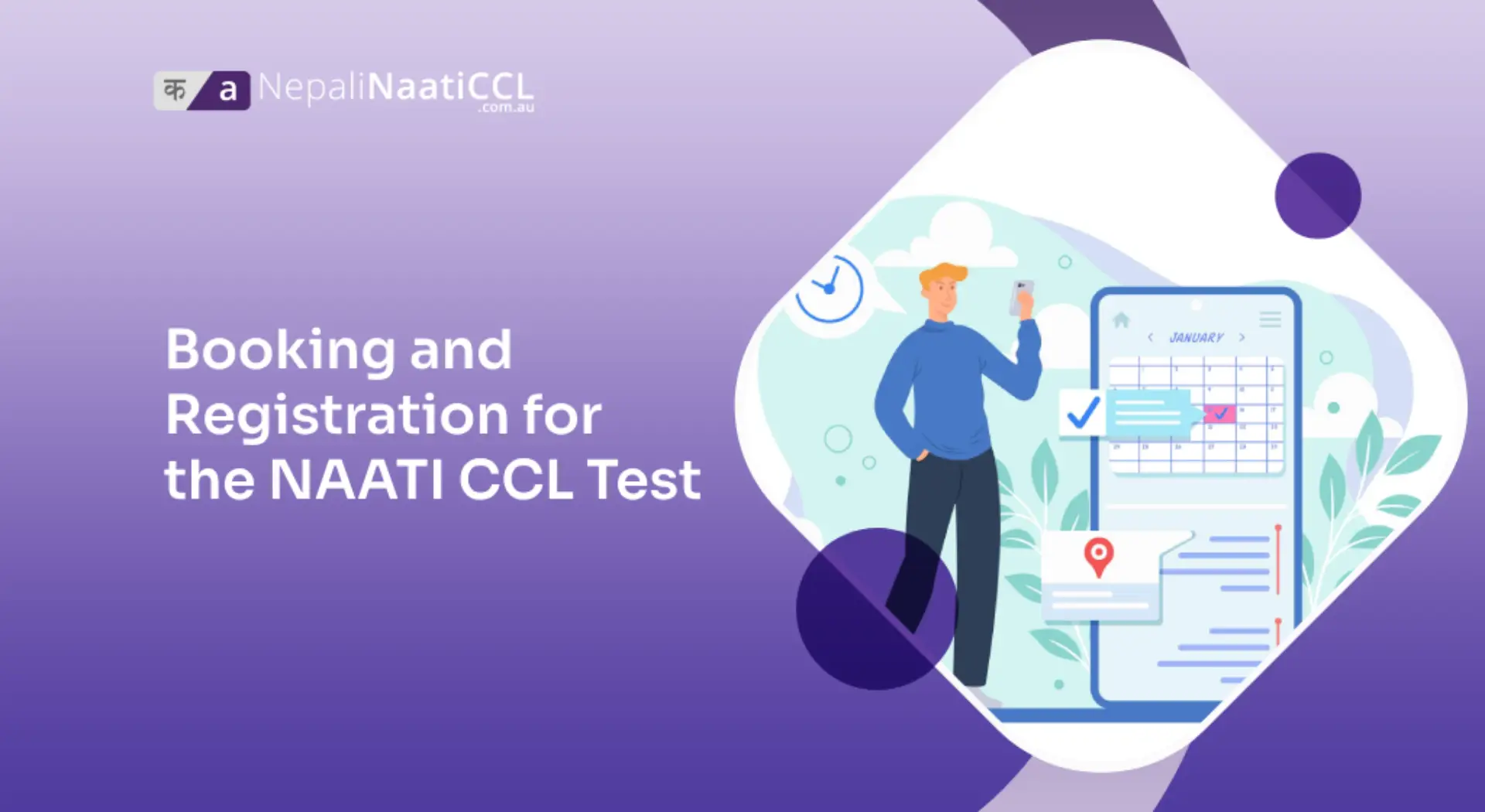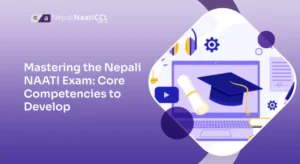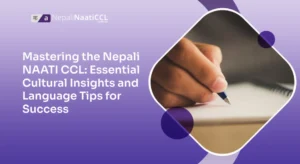If you have confidence and good preparation, it’s time for you to plan for the practical aspects of booking and registration for the NAATI CCL Test. This test validates your language competence, enhances your professional standing, and provides an edge in Australian immigration.
For starters, you need to understand the eligibility criteria for the NAATI CCL Test. Once you determine your eligibility for the NAATI CCL test, the next step is selecting the most suitable test language pair from the options available.
Moreover, this informative blog will familiarize you with the NAATI CCL test format and walk you through the step-by-step process of booking and registration for the NAATI CCL Test. Join us to navigate the ins and outs of the NAATI CCL test and fulfill the journey towards NAATI accreditation.
8 Key Components of NAATI CCL Test Format

The NAATI CCL Test follows a specific format to assess your language skills and ability to interpret and translate. Furthermore, understanding the test format is crucial for effective preparation before the NAATI CCL test day.
In this section, let’s learn eight key components of the NAATI CCL Test format:
1. Role-plays
In the NAATI CCL test, role-plays serve as dynamic language performances, similar to stepping into diverse, real-life scenarios.
Upon receiving a scenario card, you are presented with intricate details about your role and the theme of the conversation. The scenarios cover a spectrum of routine experiences, ranging from medical visits to resolving issues at a financial institution.
As you inhabit one of the roles, whether as a customer seeking assistance or a service provider offering help, your language skills take center stage. The key to success is maintaining composure and navigating the conversation with fluency.
This involves active listening, as you respond based on cues from the other participant, leveraging the source language text to guide your translations seamlessly. However, it might seem quite difficult in the initial phase.
In addition to linguistic accuracy, cultural awareness becomes a pivotal aspect. Your responses must reflect linguistic finesse and demonstrate an understanding of cultural nuances.
2. Source Language Text
In the NAATI CCL test, the “Source Language Text” serves as a critical element that shapes the entire linguistic performance.
As the candidate encounters the source language text, their initial task is to comprehend its content thoroughly. This comprehension involves not just understanding the literal meaning of the words but expressing the context and nuances within the text.
Furthermore, the source language text acts as a guide during the role-play scenarios. It becomes a reference point, offering cues and clues influencing the candidate’s responses.
Effective note-taking is a skill connected to the source language text. As candidates engage with the material, they strategically jot down key points, essential details, or noteworthy terms.
Moreover, the source language text contributes significantly to the cultural dimension of the test. It encapsulates linguistic intricacies and cultural subtleties embedded in the content. This integration of cultural awareness elevates language performance, showcasing a holistic understanding of communication beyond the literal translation of words.
3. Language Pair
In a nutshell, the language pair is the two languages involved in the role-play. One is your native language, and the other is English. You’ll be translating between these two buddies during the test.
Now, let’s break it down a bit more. If your native language is, say, Hindi, then Hindi becomes your source language. The source language is where you get that chunk of text to review before the role-play kicks in.
On the flip side, English is your target language. It’s where you express yourself during the conversation.
Here’s the tricky part – you must ensure your translations are spot on. The folks at NAATI are keeping an eagle eye on how well you switch between the source and target languages. Smooth transitions are the name of the game.
Hence, the language pair is your native language and English. Get that rhythm right, avoid NAATI CCL mistakes, and you’re on your way to acing the NAATI CCL test!
4. Note-taking
When the role-play scenario unfolds, you’re not expected to be a memory wizard. Instead, grab your pen and paper – notes are your allies.
As you listen to the source language text and engage in the conversation, jot down critical details, essential terms, or anything that stands out.
These notes become your lifeline during the role-play, keeping you on track and preventing those “uh-oh” moments. Similarly, the key is to be strategic with your notes.
Now, let’s talk about the timing.
You’ve got limited time for note-taking, so practice is key. Hone those skills to identify the critical details and translate them effectively quickly.
And remember, your notes are for your eyes only. Nobody else gets to see them, so don’t worry about neatness or perfection. It’s about what works for you.
So, note-taking is your sidekick in the NAATI CCL test. Get those notes down, and you’re one step closer to mastering the NAATI CCL test!
5. Speaking Modes
In the NAATI CCL test, you’ve got different ways of talking. It’s like using different flavors of communication during the role-plays.
One way is the Consecutive Mode. It’s like taking turns in a conversation. You listen, take a moment, and then respond. It’s all about keeping it smooth and natural.
Then there’s the Simultaneous Mode. This is like doing two things at once – listening and translating together. It might be a bit tricky at first, but you can get the hang of it with practice. It adds a dynamic touch to your language skills.
Furthermore, another mode is the Retelling Mode. It’s like being the storyteller. You listen, let it sink in, and then share it in another language. The trick is to capture the main idea and say it clearly.
Lastly, there’s the Repetition Mode. It’s like echoing what you hear but in the other language. It helps show that you can repeat information accurately, keeping the conversation flowing.
So, these speaking modes are like tools for your role-plays.
Each one brings a different vibe to your language game. Whether it’s the back-and-forth talk, the multitasking, the storytelling, or the echoing – getting good at these modes is the key to doing well in the NAATI CCL test.
Embrace the variety, practice your skills, and get ready to shine in the language spotlight!
6. Accuracy and Fluency
Accuracy is about getting it right. When you’re translating, you want to ensure the words match up. It’s the precision of your language skills – like aiming for the center of the target.
Now, onto fluency. This is the smoothness in your language flow. It’s not just about being right; it’s about being right without tripping over your words.
No awkward pauses or stumbling, just a confident linguistic stream.
Here’s the catch – you need both accuracy and fluency. Practice is your best pal here.
And don’t stress too much. It’s not about being a robot reciting words; it’s about hitting the right notes with a natural rhythm.
So, aim for that sweet spot where accuracy meets fluency, practice your moves, and you’ll be on your way to acing the language game in the NAATI CCL test!
7. Translation
Translation is more than swapping words between your native language and English. It’s about getting the real meaning across, not just word by word.
A tricky part is dealing with unique phrases and cultural stuff. Languages have ways of saying things, and translation means figuring out these language puzzles.
In the NAATI CCL test, you’re not only judged on getting the words right but also on fitting your translation into the role-play context. Using the right words at the right time in a real-life situation makes the difference.
Timing matters, too. You need to be quick but accurate. It’s like a fast dance where you hit the right moves at the right moment, capturing what’s important.
Lastly, mastering this skill shows you’re good with words and ace at real-life communication.
8. Cultural Awareness
Cultural awareness goes beyond just knowing the language; it’s about getting the vibe of a different culture.
In the test, you’re not only showing that you know the language well but also that you grasp the cultural twists. Hence, when you’re translating, it’s not just about finding the right words; it’s about capturing the cultural flavors to make the whole experience more authentic.
Also, cultural awareness makes sure your responses sound right and feel right in a cultural sense. It’s not just about language; it’s about understanding and respecting the cultural context.
It’s about connecting with the context, understanding the cultural cues, and responding in a way that fits seamlessly. Mastering this adds depth and authenticity to your language performance.
How To Select Suitable Language Pair for Your NAATI CCL Test?
Selecting the suitable test language pair is the initial and very vital decision you must make before you even start preparing for the NAATI CCL Test. This choice requires careful consideration to match best your language skills, immigration aspirations, and personal interests.
Firstly, reflect on your proficiency. Assess which language you are most fluent in, both in speaking and understanding.
This language becomes your source language in the test. It’s essential to choose the language where you can express yourself naturally and easily comprehend complex ideas.
Moreover, think about the demand in your chosen field. Consider which language is more relevant if you’re aiming for career opportunities in a specific industry. For example, proficiency in a widely spoken business language might be advantageous if you’re eyeing roles in international business.
Another critical aspect is your comfort level with the language pair. Choose a language pair that you are comfortable working with during the test.
This comfort extends to your ability to translate effectively and confidently engage in role-plays.
Additionally, consider the cultural component. Language and culture often go hand in hand. Opt for a language pair where you are linguistically adept and culturally aware.
This awareness enhances your ability to understand and convey the cultural nuances embedded in the test scenarios.
Lastly, seek advice if needed. Consult with mentors, language experts, or peers who have experience with the NAATI CCL test. Their insights can provide valuable perspectives, helping you make an informed decision based on practical considerations and real-world applications.
By carefully weighing these factors, you can choose a language pair that aligns with your strengths and maximizes your chances of success in the NAATI CCL test, and streamline your path to immigrating permanently to Australia.
Booking and Registration for the NAATI CCL Test

You might be wondering how to start with the NAATI CCL test. Well, no worries; in the following section, we will briefly discuss step by step process of booking and registration for the NAATI CCL test.
Step 1: Explore Test Information
To start your NAATI CCL test journey, the initial step involves exploring comprehensive test information. Begin by navigating to the official NAATI website.
Once on the website, explore the specifics of each test language. Consider factors such as your proficiency level, personal comfort with the language, and the relevance of the language to your career goals.
Furthermore, familiarize yourself with any additional information or requirements related to the test. This might include specific instructions, test formats, or materials to aid your preparation.
As you explore the test information, think of it as laying the foundation for a well-informed decision. Your understanding of the available languages, test dates, and associated details will guide you in selecting the most suitable language pair for the NAATI CCL test.
Step 2: Create a NAATI Account
The second step in booking and registration for the NAATI CCL test is creating an account on the NAATI website.
Begin this process by visiting the official NAATI website. Here, you’ll encounter a user-friendly interface designed for ease of navigation.
Likewise, creating an account involves providing the necessary details, much like filling out a registration form. This step ensures that you are securely connected to the NAATI platform, gain access to the registration portal, and proceed with booking your test.
Once established, this account allows you to explore test details, book test slots, and access preparation materials.
Also, you may be prompted to verify your identity and set up account security features during the account creation process. So, proceed with this step thoughtfully.
Step 3: Select the Test Date
Moving forward in the NAATI CCL test journey, the third step involves a pivotal decision – selecting the test date.
Upon logging into your established NAATI account, you gain access to the available test dates. This digital calendar allows you to explore the options.
Similarly, choose a date that harmonizes with your schedule and provides sufficient time for thorough preparation. Consider factors such as work commitments, personal obligations, and the pace at which you can effectively hone your language skills.
The selection of the test date is a strategic move, influencing the entire preparation timeline. Hence, be mindful of any external factors that might impact your availability on the chosen date, striving for a balance between convenience and readiness.
By selecting a date, you are not only reserving a spot for yourself but also establishing a concrete goal to work towards. Mindfully make your selection to pass the NAATI CCL test on your first attempt.
Step 4: Pay the Test Fee
Advancing further in the NAATI CCL test journey, the fourth step is a crucial financial transaction – paying the test fee.
After selecting your preferred test date, log into your NAATI account to initiate the payment process. The test fee covers the costs associated with organizing and administering the NAATI CCL test.
Additionally, NAATI provides various payment methods to accommodate candidates. This flexibility is designed to ensure a seamless and accessible payment experience.
Completing the payment for the test fee symbolizes your commitment and readiness to participate in the NAATI CCL test. Also, the paid test fee is your confirmation, marking your official entry into the final stages of preparation for the NAATI CCL test.
Step 5: Confirmation and Test Details
Progressing to the fifth step in your NAATI CCL test journey involves receiving confirmation and essential test details.
Following the payment of the test fee, expect to receive a confirmation email or notification via your NAATI account. This correspondence serves as your official acknowledgment, confirming your successful registration for the test.
Within this confirmation communication, you will find vital test details. These include your confirmed test date and other pertinent information regarding the testing process.
In addition to the test date and location, the confirmation often includes information on what to bring to the test center, any additional materials required, and the expected duration of the test.
As you approach this step, anticipate the confirmation as the official green light for your participation in the NAATI CCL test. With the test details you received in hand, you are now well-prepared to navigate the final stages leading up to the official test day.
Step 6: Prepare for the Test
As you venture into the final phase of your NAATI CCL test journey, the sixth step involves diligent preparation.
Commence your preparation by revisiting the test format and structure. Familiarize yourself with the role-play scenarios, language pairs, and the expectations for each test component.
Likewise, practice your language skills regularly in the lead-up to the test day. Engage in conversations, listen to recordings, and work on translating texts between your source language and English.
Consider seeking feedback from mentors, language experts, or peers on your language skills. Constructive feedback provides valuable insights into areas for improvement and helps refine your approach.
In the days leading up to the test, ensure you’re well-rested and mentally prepared. Think of this as the final preparations before stepping onto the stage. Take time for self-care, relax, and approach the test day confidently and positively.
After the NAATI CCL Test
After completing the NAATI CCL Test, the first step is patiently waiting for the results. However, once the results are available, NAATI will notify you via email or on the NAATI website. This notification will inform you whether you have passed or failed the test.
Initially, you may experience a mix of emotions. It’s natural to feel a sense of accomplishment for completing the test and showcasing your language skills.
Hence, take a moment to acknowledge your efforts and the progress you’ve made throughout your preparation journey.
While the test results are being processed, consider leveraging this time to enhance your language proficiency further. Engage in continuous language practice, explore additional learning resources, and stay attuned to developments in your chosen language pair.
Once the results are released, carefully review the feedback provided by NAATI. Whether you achieve the desired outcome or identify areas for improvement, the feedback is valuable for your linguistic growth.
If you have successfully passed the NAATI CCL Test, congratulations! You can proceed with the certification process, which involves submitting the necessary documents to NAATI. Carefully follow the instructions NAATI provides and submit the required documents within the specified timeframe.
Upon successful certification, NAATI will grant you language accreditation. This accreditation holds significant value in the interpreting and translation industry. Moreover, it will also help you earn five Australian PR points.
Also, Suppose you are aiming to use this certification professionally. In that case, you must continuously expand your knowledge and hone your abilities by participating in workshops, attending conferences, taking advanced courses, and staying updated with industry trends to remain competitive.
Conclusion
In conclusion, completing the NAATI CCL Test is a significant achievement that opens doors to exciting opportunities in the professional fields of interpreting and translation. After reading this informative blog, we hope you are clear on booking and registration for NAATI CCL test.
Additionally, to support your preparation, NepaliNAATICCL is an online portal that offers free NAATI CCL test samples and a wide range of NAATI CCL test preparation materials.
Accessing these resources can significantly assist you in refining your language skills, familiarizing yourself with the test format, and increasing your chances of success in earning five valuable Australian PR points. Utilizing resources helps you prepare yourself confidently before the test day.
Although, if you still need clarification about anything related to NAATI CCL, our team is always ready to assist you. Ultimately, the conclusion of the booking and registration process marks the beginning of your linguistic journey.
Best of luck on your language-learning journey!
FAQ
Q.1: How do I choose the right language pair for the test?
Selecting the appropriate language pair involves considering factors such as your language proficiency, relevance to your career goals, and comfort level. Choosing a language where you are fluent and aligns with your intended career path is recommended, as this enhances your chances of success in the test.
Q.2: What is the format of the NAATI CCL test?
The test comprises role-plays and translation tasks. Candidates are presented with a source language text, engage in role-plays simulating real-life scenarios, and perform translations between the source language and English. The test assesses both linguistic proficiency and cultural awareness.
Q.3: How do I prepare for the NAATI CCL test?
Effective preparation involves understanding the test format, regular language practice, and utilizing preparation materials provided by NAATI. Engaging in conversations, practicing translation, and seeking feedback on your language skills are crucial steps. Additionally, awareness of cultural nuances in your chosen language pair is essential.
Q.4: What happens after I complete the NAATI CCL test?
After completing the test, candidates may experience a waiting period while the results are processed. Once released, candidates receive feedback on their performance. Successful candidates may use their results for career opportunities or migration purposes, while those with areas for improvement can use the feedback to enhance their language skills.
Q.5: Can I retake the NAATI CCL test if I don’t pass?
Yes, candidates can retake the test if they do not achieve a passing score. It’s important to carefully review the feedback provided, identify areas for improvement, and engage in additional language practice before attempting the test again. NAATI allows multiple attempts to support candidates in their language proficiency journey.
Q.6: How do I change my selected test date after booking and paying the test fee?
If you need to change your selected test date after completing the booking and payment process, it’s advisable to check NAATI’s policies regarding date changes. Contact NAATI directly for guidance on whether and how date changes can be accommodated.




